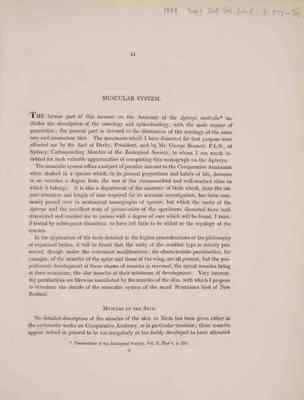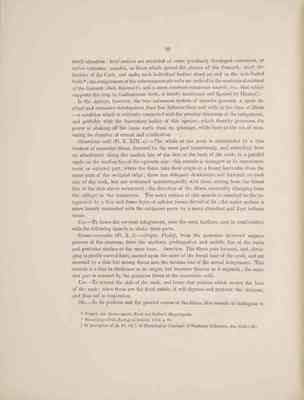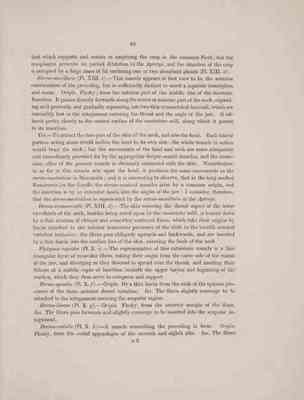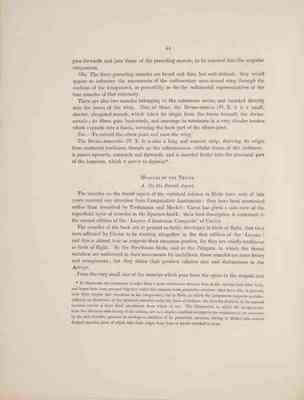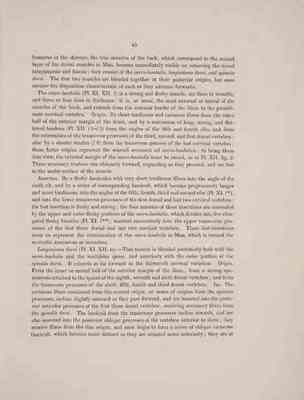Pages
61
MUSCULAR SYSTEM.
The former part of this memoir on the Anatomy of the Apteryx australis* includes the description of the osteology and splanchnology, with the male organs of generation ; the present part is devoted to the illustration of the myology of the same rare and anomalous bird. The specimens which I have dissected for that purpose were afforded me by the Earl of Derby, President, and by Mr. George Bennett, F.L.S. of Sydney, Corresponding Member of the Zoological Society, to whom I am much indebted for such valuable opportunities of completing this monograph on the Apteryx.
The muscular system offers a subject of peculiar interest to the Comparative Anatomist when studied in a species which , in its general proportions and habits of life, deviates in so extreme a degree from the rest of the circumscribed and well-marked class to which it belongs. It is also a department of the anatomy of birds which, from the minute attention and length of time required for its accurate investigation, has been commonly passed over in anatomical monographs of species, but which the rarity of the Apteryx and the excellent state of preservation of the specimens dissected have both stimulated and enabled me to pursue with a degree of care which will be found, I trust, if tested by subsequent dissection, to have left little to be added to the myology of the species.
In the application of the facts detailed to the higher generalizations of the philosophy of organized bodies, it will be found that the unity of the ornithic type is strictly preserved, though under the extremest modifications ; the characteristic peculiarities, for example, of the muscles of the spine and those of the wing, are all present, but the proportionate development of these classes of muscles is reversed, the spinal muscles being at their maximum, the alar muscles at their minimum of development. Very interesting peculiarities are likewise manifested by the muscles of the skin, with which I propose to introduce the details of the muscular system of the small Struthious bird of New Zealand.
MUSCLES OF THE SKIN.
No detailed description of the muscles of the skin in Birds has been given either in the systematic works on Comparative Anatomy, or in particular treatises ; these muscles appear indeed in general to be too irregularly or too feebly developed to have attracted
* Transactions of the Zoological Society, Vol. II. Part 4, p. 257.
62
42
much attention : brief notices are recorded of some peculiarly developed cutaneous , or rather cuticular, muscles, as those which spread the plumes of the Peacock, erect the hackles of the Cock, and make each individual feather stand on end in the web-footed birds* ; the compressors of the subcutaneous air-cells are noticed in the anatomical account of the Gannett (Sula Bassana#) ; and a more constant cutaneous muscle, viz. that which supports the crop in Gallinaceous birds, is briefly mentioned and figured by Hunter ##.
In the Apteryx, however, the true cutaneous system of muscles presents a more distinct and extensive development than has hitherto been met with in the class of Birds - a condition which is evidently connected with the peculiar thickness of the integument, and probably with the burrowing habits of this species, which thereby possesses the power of shaking off the loose earth from its plumage, while busy in the act of excavating its chamber of retreat and nidification.
Constrictor colli (Pl. X.XIII.a)- The whole of the neck is surrounded by a thin stratum of muscular fibres, directed for the most part transversely, and extending from an attachment along the median line of the skin at the back of the neck to a parallel raphe on the median line of the opposite side : this muscle is strongest at its commencement or anterior part, where the fibres take on their origin in a broad fasciculus from the outer part of the occipital ridge ; these run obliquely downwards and forwards on each side of the neck, but are continued uninterruptedly with those arising from the dorsal line of the skin above mentioned ; the direction of the fibres insensibly changing from the oblique to the transverse. The outer surface of this muscle is attached to the integument by a thin and dense layer of cellular tissue, devoid of fat ; the under surface is more loosely connected with the subjacent parts by a more abundant and finer cellular tissue.
Use. - To brace the cervical integument, raise the neck feathers, and in combination with the following muscle to shake these parts.
Sterno-cervicalis (Pl. X. b) - Origin. Fleshy, from the posterior incurved angular process of the sternum, from the ensiform prolongation and middle line of the outer and posterior surface of the same bone. Insertion. the fibres pass forward, and, diverging in gently curved lines, ascend upon the sides of the broad base of the neck, and are inserted by a thin but strong fascia into the median line of the dorsal integument. This muscle is a line in thickness at its origin, but becomes thinner as it expands ; the anterior part is covered by the posterior fibres of the constrictor colli.
Use.- To retract the skin of the neck, and brace that portion which covers the base of the neck ; when these are the fixed points, it will depress and protract the sternum, and thus aid in inspiration.
Obs.- In its position and the general course of the fibres, this muscle is analogous to
* Nitzsh, art. Dermorhynchi, Ersch und Gruber's Encyclopedie. # Proceedings of the Zoological Society, 1832, p.91. ## In description of pl. 10, vol.i. of Physiological Catalogue of Hunterian Collection, 4to. 1833-1841.
63
43
that which supports and assists in emptying the crop in the common Fowl ; but the oesophagus presents no partial dilation in the Apteryx, and the situation of the crop is occupied by a large mass of fat enclosing one or two absorbent glands (OL. XIII.a 1).
Sterno-maxillaris (Pl. XIII. c). - This muscle appears at first view to be the anterior continuation of the preceding, but is sufficiently distinct to merit a separate description and name. Origin. Fleshy ; from the anterior part of the middle line of the sternum. Insertion. It passes directly forwards along the under or anterior part of the neck, expanding as it proceeds, and gradually separating into two thin symmetrical fasciculi, which are insensibly lost in the integument covering the throat and the angle of the jaw. It adheres pretty closely to the central surface of the constrictor colli, along which it passes to its insertion.
Use.- To retract the fore-part of the skin of the neck, and also the head. Each lateral portion acting alone would incline the head to its own side : the whole muscle in action would bend the neck ; but the movements ot the head and neck are more adequately and immediately provided for by the appropriate deeper-seated muscles, and the immediate office of the present muscle is obviously connected with the skin. Nevertheless, in so far as this muscle acts upon the head, it produces the same movements as the sterno-mastoideus in Mammalia ; and it is interesting to observe, that in the long-necked Ruminants (as the Giraffe) the sterno-mastoid muscles arise by a common origin, and the insertion is by an extended fascia into the angles of the jaw : I consider, therefore, that the sterno-mastoideus is represented by the sterno-maxillaris in the Apterys.
Dermo-transversalis (Pl. XIII. d). - The skin covering the dorsal aspect of the lower two-thirds of the neck, besides being acted upon by the constrictor colli, is braced down by a thin stratum of oblique and somewhat scattered fibres, which take their origins by fasciae attached to the inferior transverse processes of the sixth to the twelfth cervical vertebrae inclusive ; the fibres pass obliquely upwards and backwards, and are inserted by a thin fascia into the median line of the skin, covering the back of the neck. Platysma myoides (Pl. X. e). - The representative of this cutaneous muscle is a thin triangular layer of muscular fibres, taking their origin fom the outer side of the ramus of the jaw, and diverging as they descend to spread over the throat, and meeting their fellows at a middle raphe of insertion beneath he upper larynx and beginning of the trachea, which they thus serve to compress and support.
Dermo-spinalis (Pl. X. f).- Origin. By a thin fascia from the ends of the spinous processes of the three anterior dorsal vertebrae. Ins. The fibres slightly converge to be attached to the integument covering the scapular region.
Dermo-iliacus (Pl. X. g). -Origin. Fleshy, from the anterior margin of the ilium. Ins. The fibres pass forwards and slightly converge to be inserted into the scapular integument.
Dermo-costalis (Pl. X. h). - A muscle resembling the preceding in form. Origin. Fleshy, from the costal appendages of the seventh and eighth ribs. Ins. The fibres
G2
64
44
pass forwards and join those of the preceding muscles, to be inserted into the scapular integument.
Obs. The three preceding muscles are broad and thin, but well-defined ; they would appear to influence the movements of the rudimentary spur-armed wing through the medium of the integument, as powerfully as do the rudimental representatives of the true muscles of that extremity.
There are also two muscles belonging to the cutaneous series, and inserted directly into the bones of the wing. One of these, Dermo-ulnaris (Pl. X. i) is a small, slender, elongated muscle, which takes its origin from the fascia beneath the dermocostalis ; its fibres pass backwards, and converge to terminate in a very slender tendon which expands into a fascia, covering the back part of the elbow-joint.
Use._ to extend the elbow-joint and raise the wing. The Dermo-humeralis (Pl.X.k) is also a long and narrow strip, deriving its origin from scattered tendinous threads in the subcutaneous cellular tissue of the abdomen : it passes upwards, outwards and forwards, and is inserted fleshy into the proximal part of the humerus, which it serves to depress *.
MUSCLES OF THE TRUNK. A. On the Dorsal Aspect.
The muscles on the dorsal aspect of the vertebral column in Birds have only of late years received any attention from the Comparative Anatomists : they have been mentioned rather than described by Tiedmann and Meckel : Carus has given a side-view of the superficial layer of muscles in the Sparrow-hawk ; their best description is contained in the second edition of the 'Lecons d'Anatomie Comparee' of Cuvier.
The muscles of the back are in general so feebly developed in birds of flight, that they were affirmed by Cuvier to be wanting altogether in the first edition of the 'Lecons": and this is almost true as respects their carneous portion, for they are chiefly tendinous in birds of flight. In the Struthious birds, and in the Penguin, in which the dorsal vertebrae are unfettered in their movements by anchylosis, these muscles are more fleshy and conspicuous ; but they attain their greatest relative size and distinctness in the Apteryx.
From the very small size of the muscles which pass from the spine to the scapula and
*In Mammalia the cutaneous muscles form a more continuous stratum than in the Apteryx and other birds, and hence have been grouped together under the common term panniculus carnosus ; they have also, in general, both their origins and insertions in the integument ; but in Birds, in which the integument supports so extraordinary an abundance of the epidermic material under the form of feathers, the muscles destined to its especial motions require a more fixed attachment from which to act. The Rhinoceros, in which the integuments, from the thickness and density of the corium, are in a similar condition as regards the resistance to be overcome by the skin-muscles, presents an analogous condition of its panniculus carnosus, having it divided into several distinct muscles, most of which take their origin from bone or fasciae attached to bone.
65
45
humerus in the Apteryx, the true muscles of the back, which correspond to the second layer of the dorsal muscles in Man, become immediately visible on removing the dorsal integuments and fasciae ; they consist of the sacro-lumbalis, longissimus dorsi, and spinalis dorsi. The first two muscles are blended together at their posterior origins, but soon assume the disposition characteristic of each as they advance forwards.
The sacro--lumbalis (Pl. XI. XII. l) is a strong and fleshy muscle, six lines in breadth, and three or four lines in thickness : it is, as usual, the most external or lateral of the muscles of the back, and extends from the anterior border of the ilium to the penultimate cervical vertebra. Origin. By short tendinous and carneous fibres from the outer half of the anterior margin of the ilium, and by a succession of long, strong, and flattened tendons (Pl. XII. l 1-l 5) from the angles of the fifth and fourth ribs, and from the extremities of the transverse processes of the third, second, and first dorsal vertebrae ; also by a shorter tendon ( l 6) from the transverse process of the last cervical vertebra ; these latter origins represent the musculi accessorii ad sacro-lumbalem ; to bring them into view, the external margin of the sacro-lumbalis must be raised, as in Pl. XII.fig. 2. These accessory tendons run obliquely forward, expanding as they proceed, and are lost in the under surface of the muscle.
Insertion. By a fleshy fasciculus with very short tendinous fibres into the angle of the sixth rib, and by a series of corresponding fasciculi, which become progressively longer and more tendinous into the angles of the fifth, fourth, third and second ribs (Pl. XI. l*), and into the lower transverse processes of the first dorsal and last two cervical vertebrae : the last insertion is fleshy and strong ; the four anterior of these insertions are concealed by the upper and outer fleshy portions of the sacro-lumbalis, which divides into five elongated fleshy bundles (Pl. XI. l **), inserted successively into the upper transverse processes of the first three dorsal and last two cervical vertebrae. These last insertions seem to represent the continuation of the sacro-lumbalis in Man, which is termed the cervicalis descendens or ascendens.
Longissimus dorsi (PL. XI. XII. m). - This muscle is blended posteriorly both with the sacro-lumbalis and the multifus spinoe, and anteriorly with the outer portion of the spinalis dorsi. It extends as far forward as the thirteenth cervical vertebrae. Origin. From the inner or mesial half of the anterior margin of the ilium ; from a strong aponeurosis attached to the spines of the eigth, seventh and sixth dorsal vertebrae ; and from the transverse processes of the sixth, fifth, fourth and third dorsal vertebrae. Ins. The carneous fibres continued from the second origin, or series of origins from the spinous processes, incline slightly outward as they pass forward, and are inserted into the posterior articular processes of the first three dorsal vertebrae, receiving accessory fibres from the spinalis dorsi. The fasciculi from the transverse processes incline inwards, and are also inserted into the posterior oblique processes of the vertebrae anterior to them ; they receive fibres from the iliac origin, and soon begin to form a series of oblique carneous fasciculi, which become more distinct as they are situated more anteriorly ; they are at
